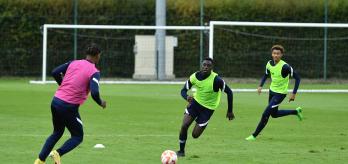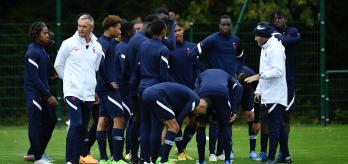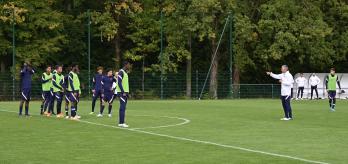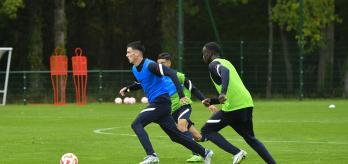To deal with all defensive situations, including 1v1 and 1v2 scenarios, players must understand when to press aggressively with a view to preventing opposing players from turning on the ball. Knowing whether to engage a player or anticipate a key pass are also key elements when defending in 1v1 scenarios, whilst subtle details, such as using their body to disrupt an attacker, can also give a defender an advantage in such situations.
In this session, the head coach of the Costa Rica women’s national team, Beni Rubido, and the side’s assistant coach, Edgar Rodríguez, deliver a series of exercises that focus on defensive actions. The first drill prepares players to deal with isolated 1v2 defensive scenarios. This is followed by a 1v1 exercise in which players are tasked with pressing their opponent. The third exercise places the defender in a 1v3 numerical disadvantage, and they are asked to prevent the attacker dribbling past them or playing a one-two around them. The session ends with a 6v6+6+GKs exercise and a 6v6+GKs small-sided game, both of which are played on a reduced-sized pitch.
Session overview
Key coaching points
-
Players should decide whether it is best to engage an oncoming player or try to delay them and anticipate a pass to make an interception.
-
Players should disrupt opponents and keep them at close quarters by using their arms to put them off balance or prevent them from turning.
-
Players should adjust their positioning and body orientation based on the distance from, and actions of, their opponents in 1v1 and 1v2 scenarios. Players should protect the space in behind them if necessary.
-
If a player receives the ball with their back to goal, defenders should press immediately to prevent them from turning.
Part 1: Defending isolated 1v2 scenarios
The first exercise enables players to work on isolated defensive situations. The defender is tasked with reading the opposition’s intentions when executing a wall pass and in 1v2 and 1v1 scenarios.
-
Mark out three 30x20m exercise areas parallel to one another.
-
Place 2 mini-goals at one end of each exercise area and 2 cones at the opposite end.
-
Place a green cone in the centre of the exercise area and a red cone 5m in front of it.
-
Position 2 players at the red cone on the right-hand side of the end of the exercise area (D) and 1 player on the red cone on the left-hand side (E).
-
Position a player on the green cone (C) and another player on the red cone (B).
-
Position 2 players between the 2 mini-goals (A).
-
A passes the ball to B.
-
C presses B from behind.
-
B plays a lay-off to A, who passes to either D or E.
-
D or E must decide whether to play a one-two with B, thereby creating a 2v1 scenario, or to dribble the ball towards the mini-goal on their side of the exercise area.
-
In all scenarios, C’s objective is to intercept passes or dispossess the opponent.
-
After each sequence, all players rotate to the next station.
-
C can decide whether to hold their ground or to press B, who, depending on the intensity of C’s press, must decide whether to lay the ball off to A or turn to play the ball to D or E.
-
Defenders should use their body in 1v1 scenarios to impede the attacker’s progress.
-
When defending wall passes, players should apply pressure quickly to prevent the receiver from turning.
-
Defenders should identify the right moment to step up and engage the ball carrier or wait to intercept a wall pass.
-
Defenders should try to keep attackers guessing by feigning engagement only to then anticipate and block the pass.
-
The receiver should scan over their shoulder to read the defender’s body orientation with a view to preventing them from making an interception.
Part 2: 1v1 – preventing passes
The second exercise reinforces defensive principles with practical application to real-game scenarios. The drill simulates a striker pressing a centre-back who receives a pass in two separate scenarios.
-
Mark out three 15x15m exercise areas parallel to one another.
-
Place 2 mini-goals at one end of each exercise area.
-
Split the players into 2 teams (blues and oranges).
-
Place 3 blue players at one end of the exercise area and 3 orange players at the other end.
-
The coach plays the ball to the first orange player from their position on the outside of the exercise area.
-
As soon as the coach plays the pass, the first blue player enters the exercise area and presses the ball.
-
The orange player aims to overcome the blue player and play a pass into either mini-goal.
-
Once the first sequence is over (i.e. the orange player plays the ball into a mini-goal or the blue player gains possession), the coach immediately feeds a second pass towards the orange player, who is now facing away from the mini-goal as they return towards their starting position.
-
The orange player must turn and once again try to overcome the blue player’s press and pass the ball into either of the mini-goals.
-
If the orange player plays a pass into a mini-goal or the blue player wins the ball, a new player from each team enters the exercise area and the sequence is repeated.
-
Rotate the teams so that all players have the opportunity to occupy both defensive and attacking roles.
-
Defenders should adjust their positioning and the intensity of their press based on the distance between them and the ball carrier.
-
Defenders should shepherd the ball carrier towards one side to limit their passing options and to facilitate an interception.
-
Defenders should use their hands to disrupt and unsettle an opponent who is facing their own goal and make contact with them to put them off balance when they try to turn or take a touch.
-
In the second phase of the sequence, defenders should avoid affording the receiving player the space in which to turn and should press aggressively.
Part 3: 1v3 defending wall passes
The final part of the session focuses on set pieces (corner kicks and free kicks) with opposition. Head coach Karla Maya works with the attacking team, while her assistant, Miguel Gamero, coaches the defending team.
-
Mark out three 15x15m exercise areas parallel to one another.
-
Place 2 mini-goals at one end of each exercise area.
-
Position 2 blue players between the mini-goals, 2 orange players at the opposite end of the exercise area and an orange player on the outside of each side of the exercise area.
-
Give the blue players a ball.
-
The blue player passes the ball to the orange player and follows their pass to press the orange player.
-
The orange player has to decide whether to play a wall pass with either team-mate positioned on the sides of the exercise area or to engage in a 1v1 scenario against the blue player.
-
The orange player aims to score in either mini-goal.
-
The blue player is tasked with intercepting passes and preventing the orange player from passing the ball into either mini-goal.
-
The orange players positioned at the sides of the exercise area are limited to 1 touch.
-
The offside rule applies to make the exercise more realistic.
-
Each time a goal is scored or the blue player makes a block, new players enter the exercise area.
-
After a set period of time, the teams are rotated to ensure that all players have the opportunity to occupy both defensive and attacking roles.
- The orange players positioned on the outside of the exercise area can take 1 or 2 touches.
-
Defenders should reduce the space behind them to avoid being vulnerable to a wall pass.
-
After the ball is played out wide, defenders should focus on disrupting the attacker’s run by occupying the space in front of them.
-
If the defender is not close enough to engage with the attacker and they are able to play a wall pass, the defender should take the shortest path to the mini-goal.
-
Based on the intensity of the defender’s press, the attacker must decide whether to play a wall pass or engage in a 1v1 scenario.
Part 4: 6v6+6+GKs – preventing ball progression
The exercise involves larger numbers and distances than the previous drills and takes the form of a small-sided game that focuses on pressing and build-up play. Players are asked to defend in numbers and to apply the defensive principles worked on throughout the session in a real-game scenario.
-
Use half of a full-size pitch.
-
Position a full-size goal at each end of the exercise area.
-
Place a goalkeeper in each goal.
-
Mark out a 5-metre-deep zone in the middle of the exercise area.
-
Split the group into 3 teams of 6 (oranges, blues and greens).
-
Set the oranges and blues up in one half of the exercise area and the greens in the other half.
-
Organise the 3 teams in a 4-2 formation.
-
The exercise begins with the oranges in possession.
-
The oranges aim to build up play in their half of the exercise area.
-
The blues press the oranges and aim to win the ball.
-
The greens wait in the other half of the exercise area.
-
The oranges look to connect with the greens. If they manage to do so, the blues press in the half of the pitch occupied by the greens.
-
If the blues win the ball, they become the in-possession team in the half of the pitch in which they won the ball, and the team that lost possession become the pressing team.
-
Players can only progress play into the other half by carrying the ball into it.
-
To progress play, players must seek passing lanes with attacking midfielders positioned between the lines.
-
Applying the defensive principles worked on in previous exercises, defenders should try to shut off central areas and press midfielders who may receive passes in infield areas.
-
To impede opponents and maintain a compact shape, defenders must keep in mind the distance between them and the ball carrier.
-
Defenders should attempt to press the ball carrier or, at least, apply enough pressure to disrupt their decision-making.
-
When a full-back offers width and depth, encourage them to progress play by playing forwards with their first touch.
-
Midfielders should drop to drag opponents into deeper positions, thereby creating the space to play wall passes with the full-backs.
Part 5: 6v6+GKs small-sided game
The final exercise of the session involves a small-sided game that is intended to incorporate all of the aspects practised in the previous drills. The coach grants the players greater freedom to play, providing minimal instructions. Players are tasked with applying the defensive principles worked on throughout the session.
-
Use half of a full-size pitch.
-
Position a full-size goal at each end of the exercise area.
-
Place a goalkeeper in each goal.
-
Split the group into 3 teams of 6 (oranges, blues and greens).
-
The oranges and blues contest a 6v6+GKs in the exercise area.
-
The greens wait behind one of the goals.
-
The blues aim to build play and score in the opposite goal.
-
The oranges try to dispossess the blues and score.
-
The oranges must adopt a player-to-player defensive marking system.
-
After 90 seconds of play or a goal is scored, rotate 1 of the teams. If a goal is scored, the team that conceded are replaced.
-
The coaches should focus on observing the exercise and granting the players the freedom to play whilst offering minimal tactical instructions.
-
Encourage players to keep the intensity levels up with a view to achieving the conditional objectives of the exercise.
-
When possible, defenders should reduce the distance between themselves and attackers to prevent attackers from turning, especially in central areas.
-
Shepherding an opponent in a particular direction may enable the defender to win possession and block passes or shots.















